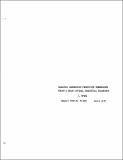| dc.description.abstract | A quasi-optimal technique ('quasi' in that the technique
discards unreasonable optimums), realized by a dynamically
evolving mixed integer program, is used to develop regional
electric power maintenance and production schedules for a
two to five year planning horizon. This sophisticated, yet
computationally feasible, method is used to develop the bulk
dispatch schedules required to meet electric power demands
at a given reliability level while controlling the associated
dollar costs and environmental impacts.
The electric power system considered is a power exchange
pool of closely coupled generation facilities supplying a
region approximately the size of New England. Associated
with a tradeoff between a given cost of production and the
relevant ecological factors, an optimum production schedule
is formulated which considers fossil, nuclear, hydroelectric,
gas turbine and pumped storage generation facilities; power
demands, reliabilities, maintenance and nuclear refueling
requisites; labor coordination, geographic considerations,
as well as various contracts such as interregional power
exchanges, interruptible loads, gas contracts and nuclear
refueling contracts.
A prerequisite of the model was that it be flexible
enough for use in the evaluation of the optimum system performance associated with hypothesized expansion patterns.
Another requirement was that the effects of changed scheduling
factors could be predicted, and if necessary corrected with
a minimum computational effort.
A discussion of other possible optimization techniques
is included, however, this study was primarily intended as a
development of a static procedure; a dynamic technique counterpart with a more probabilistic. approach is being undertaken
as a Part II of this study and at its conclusion the two
techniques will be compared. Although the inputs are precisely
defined, this paper does not deal explicitly with any of the
fabrications of the required inputs to the model. Rather,
it is meant as a method of incorporating those inputs into
the optimum operation schedule process. | en |
